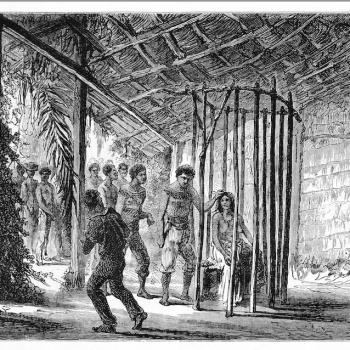Connor Wood
I visited the Midwest for a wedding last weekend. With family, I spent one day driving around Lake Pepin – a drop-dead gorgeous wide spot in the Mississippi River between Wisconsin and Minnesota, ringed on all sides by stunning, 200-foot forested bluffs and limestone cliffs. For lunch, we stopped in a café in Lake City, Minnesota, where the service was friendly, the views pleasant, and the gift shop brimming with ornamental crosses, religious inspirational plaques, and illustrated children’s Bible story books. For a Boston resident like me, it was a reminder of how religion functions in the vast majority of settings and cultures around the world: instead of being a side note or addendum to real life, it is life. It permeates the physical and mental environment, setting up a powerful ecology of symbols and ambient reminders of a transcendent worldview. The effects are both sublime and sobering.
In his magnum opus A Secular Age, the Canadian philosopher Charles Taylor argued that, for the vast majority of human history, the religious and the everyday aspects of life were not separate. Quotidian life was permanently infused with sacred symbols, references, and acts. It’s only been in the past 200 years that this total integration of the religious and the secular has begun to break down, and the religious side of things has come to be seen as merely an optional add-on to regular life. For us in the early 21st century – particularly those of us who live in large cities or college towns – it’s almost impossible to understand how profound a shift this has been in human affairs. For us, the secular world is taken for granted – it’s the way things are, at the root level. It’s common sense.
You can see how truly weird (or WEIRD) our viewpoint is when you pay attention to what humanities students call “material culture” – an academese phrase that means “the stuff that we keep around.” Religious and secular cultures are both massively informed by the physical things that characterize their respective environments. And those things are very different. Evangelical American Christian homes are liable to display lots of crosses and inspirational sayings. Observant Catholic households often have iconography and statues of saints. A secular house, meanwhile, might have nonreligious artwork, reminders of personal hobbies, or multicultural travel mementoes.

Of course, I’m generalizing. There’s no one feature that universally characterizes secular settings in the US, other than a probable lack of overt religious symbols. But in any given space, the physical objects, images, and symbols are not only signs of somebody’s personal predilections – they’re engines for the maintenance and continual reinforcement of a particular worldview. Worldviews, after all, don’t just pop fully formed into our minds. Like sand castles, they have to be continually propped up, bolstered, and sculpted back into shape in the wake of tides and time. The things we keep around ourselves are tools for doing exactly this. Hang Islamic calligraphy on every wall, and you’ll be continually prompted to see the world in one way. Fill your walls and hutches with astronomy photos and smiling pictures of Carl Sagan, and you’ll be tacitly reinforcing another view.
It’s not only stuff, either. Actions and habits are also key ingredients in the soup of worldview. Not too long ago, some American housewives would churn butter while singing religious songs. Each song might have verses of predictable lengths, and so you could time your churning according to how long it took to sing, say, eight verses of a particular hymn. But the point of singing these songs in this context wasn’t overtly religious. The point was to churn butter. It just happened to be that the songs were hymns. The result was that religious stories and references were integrated wholly – unnoticed, in fact – with the flow of everyday activity. This wholesale mingling of work and religion enabled a sort of ambient, passive reuptake of religious attitudes and symbols in the course of daily life.
This, I think, is close to how most humans around the world have lived throughout history. Consider the five times-daily call to prayer in Muslim countries: for people haggling in the marketplace, that constant (and beautiful) reminder of the Muslim faith is ambient – it’s just part of the fabric of living. You don’t have to do anything to seek it out. It comes to you. The same thing with little white Congregationalist churches in rural New England towns: the bell ringing the hours each day or tolling out Christmas carols in December is an ambient reminder of a particular culture and tradition. Each peal asks you to step into a unique place in relation to the world – even if you were just minding your business, walking down a country lane.
Cognitive scientists of religion are beginning to attend to this rich religious saturation of everyday life. One writer, Joseph Bulbulia of New Zealand’s Victoria University, describes a “charismatic ecology,” in which signs and symbols are generously scattered throughout the social landscape. These symbols – such as crosses, calligraphy, or bells – serve to activate and strengthen religious commitments, forge cultural unity, and “sync up” people with one another across wide geographical areas. These effects make society easier to coordinate, and to give individuals reassurance that the other people around them are committed to the same basic principles and values.
Of course, a major problem immediately makes itself apparent: a charismatic ecology only works within its own boundaries. For a Christian, the sound of the Muslim call to prayer doesn’t evoke ingroup solidarity or trust or noble sentiments. On the contrary: it seems alien, strange, even dangerous. It can even evoke hostility. Across the world, this unfortunate pattern repeats: different cultures’ symbol ecologies are largely mutually unintelligible. The rich tapestry of symbols that works in one setting seems like arbitrary gibberish in another.
The cosmopolitan dream, which is exemplified by modern academics in cities like Boston or Berkeley, has always been to overcome these incompatibilities – to establish a worldwide sphere of mutual, unconstrained cultural compatibility. Since the 18th century, earnest cosmopolitans have striven to marginalize religious symbol systems in order to accomplish this, because religions are what cleave us apart from one another. What we need, they believe, is a system based on enlightened, objective truths, one which will be equally valid anywhere on earth. Thus, we need a material culture that doesn’t remind us of religious traditions. We need to fill our walls and cities with secular reminders, in order to constantly evoke a universalist worldview that knows no boundaries.
And they’re partially correct. While I was sitting in the Lake City café with my family, our discussion turned to the finer points of Calvinist theology, and also brushed on Hinduism. The café was quiet and our voices carried. Our conversation marked us clearly as outsiders to the American Christianity evoked by the tschotskes around the room. Quickly, I noticed that other patrons had begun casting looks our way – looks that weren’t entirely friendly. Why? We were puncturing the bubble of faith with our highfalutin talk of objective views and foreign religions. What’s more, we were calling attention to the mechanics of faith. This faux pas was like interrupting a young courting couple to explain precisely how their body language signaled their strategic assessments of one another. It was a reminder that some things in human life only work when we don’t pay attention to them. Flirting is one of them. Ambient religion is another. And so when you expose yourself as an outsider in an insular religious setting, you are setting yourself up for a bristling reaction.
As the uncomfortable responses to our lunch conversation demonstrated, the fabric of ambient religion is easily torn, which is why cultures around the world cram themselves chock-full with so many physical and ritual reminders of their beliefs. The sociologist Peter Berger calls this the “sacred canopy:” an all-encompassing tapestry of symbols and stories that informs our understanding of reality, but which is always vulnerable to tearing or fraying. It requires constant vigilance and upkeep. One rip in the fabric – one Hindu Ganesha statuette in a café full of crosses – and the whole canopy starts to unravel. And when you put a hole in someone else’s sacred canopy, that person tends to get angry. A tremendous amount of world history can be understood in light of this simple fact.
Still, there is real comfort and value to be found within intact religious worlds. I felt it when I walked into the café, with its warm, unselfconscious flaunting of a unique culture. I could plainly see it in the middle-aged woman I sat next to on my return flight, a Christian former military officer and rural Minnesotan who spoke glowingly about being born again, about how it had made her less ambitious, less selfish, and more humble. It was lovely just to listen to her. In my experience, acquaintances who are most comfortable simply inhabiting a particular religion are happier and more balanced than those who are always probing and challenging, or who allow others to shred their sacred canopies with foreign symbols or critical suspicion.
I’m not speaking scientifically here. I just mean that there is real good and real bad to be found in religious culture. It crafts meaning and it alienates the outsider. It builds comfortable rapport within its boundaries and sets limits on who’s in and who’s out. This paradox is not neatly resolvable. It’s a genuine incompatibility, an irksome but fascinating example of the immortal tension between the universal and the particular. And I’m done trying to have it one way or another. I’ll just keep being frustrated and dazzled – equally – by the whole shebang.
______
Note: It’s conference season, which means I’m busy preparing presentations and collecting data and staying up late nights running statistics and drinking a lot of coffee. I won’t be posting every week like usual for at least another month. Thanks for being patient.












